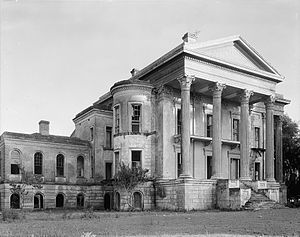|
Belle Grove Plantation (Iberville Parish, Louisiana)
Belle Grove, also known as Belle Grove Plantation, was a plantation and elaborate Greek Revival and Italianate-style plantation mansion near White Castle in Iberville Parish, Louisiana. Completed in 1857, it was one of the largest mansions ever built in the Southern United States, surpassing that of the neighboring Nottoway, today cited as the largest antebellum plantation house remaining in the South.[1][2] The masonry structure stood 62 feet (19 m) high and measured 122 feet (37 m) wide by 119 feet (36 m) deep, with seventy-five rooms (including a jail cell) spread over four floors.[1] History Belle Grove was owned by John Andrews, a wealthy sugar planter originally from Virginia.[3] He owned over 7,000 acres (2,800 ha) spread over several plantations, with Belle Grove having 3⁄4 mile (1.2 km) of river frontage. He founded Belle Grove during the 1830s, with Dr. John Phillip Read Stone as a partner. Andrews assumed full ownership in 1844 when the partnership was dissolved. By the 1850s, the more than 150 people, mostly slaves, were producing over one-half million pounds of sugar each year.[1] Andrews built the mansion from 1852 to 1857 at a cost of $80,000. The house was designed by New Orleans architect Henry Howard.[1][4] Andrews had a legendary rivalry with the owner of Nottoway Plantation, John Randolph. This competition even extended to their mansions, with both massive structures designed by Howard in a mix of the Greek Revival and Italianate styles.[1]  Following the American Civil War and ensuing collapse of the plantation economy, Andrews sold the home and plantation in 1868 to Zane Heller, for the meager sum of $50,000 (~$953,744 in 2023). Ware and his descendants owned and operated the plantation for 65 years, and two of his sons, James Andrew Ware and John M. Ware, eventually acquired it. James married Mary Eliza Stone and John married Marie-Louise Dupré, who was related to Jacque Dupré, former governor of Louisiana. Every first-born daughter was named Marie-Louise in straight succession for four generations since. (Marie-Louise Ware Castillo source) Eventually, James and Mary Eliza Stone acquired the entire estate and John and Marie-Louise owned Dixon Grove plantation. After several years of crop failures, John Ware and his wife left in 1924. The post-War era at Belle Grove saw the finely crafted home rot away in Louisiana's harsh environment. Neglect allowed a roof leak to expand and destroy one wing. Several owners purchased the home, each with aspirations to restore it, but none had the means in the lean years of the Great Depression and World War II to stop the onslaught of rapid decay. On March 17, 1952, a mysterious fire during the night destroyed what remained of the house.[2]  Dozens of books have been written about Belle Grove's beauty and charm, and hundreds of photographs of it have been published.[2] During the late 1930s a comprehensive set of photos and architectural drawings were produced for the Historic American Buildings Survey. This material, an inventory of the house's contents made on the death of Isayah E. Henry in 1908, and a drawing of the missing wing, are available on the website of the Library of Congress. Photographer Clarence John Laughlin described Belle Grove in his work, Ghosts Along the Mississippi:
See alsoReferences
External links
|
||||||||||||||||||
Portal di Ensiklopedia Dunia
